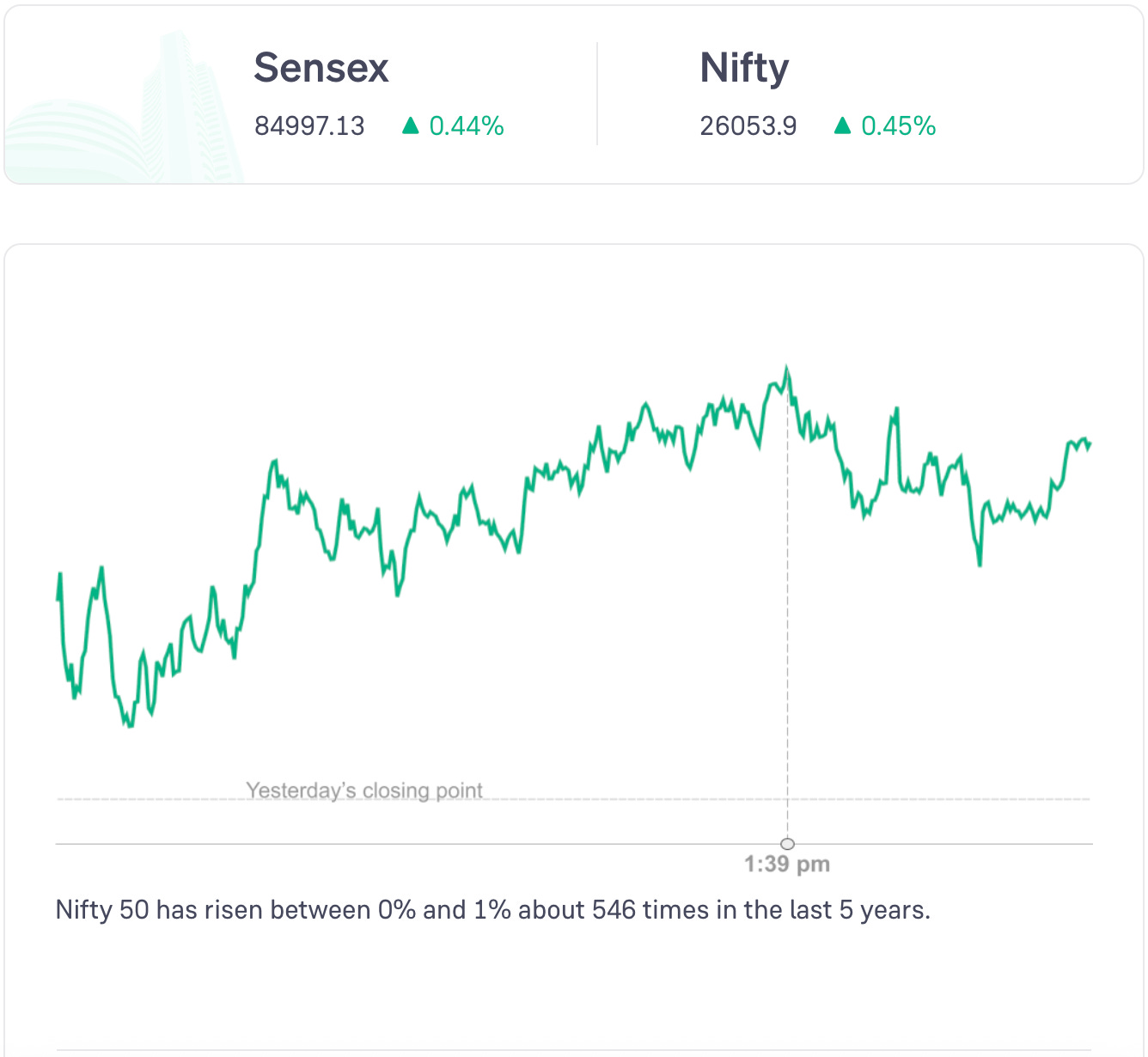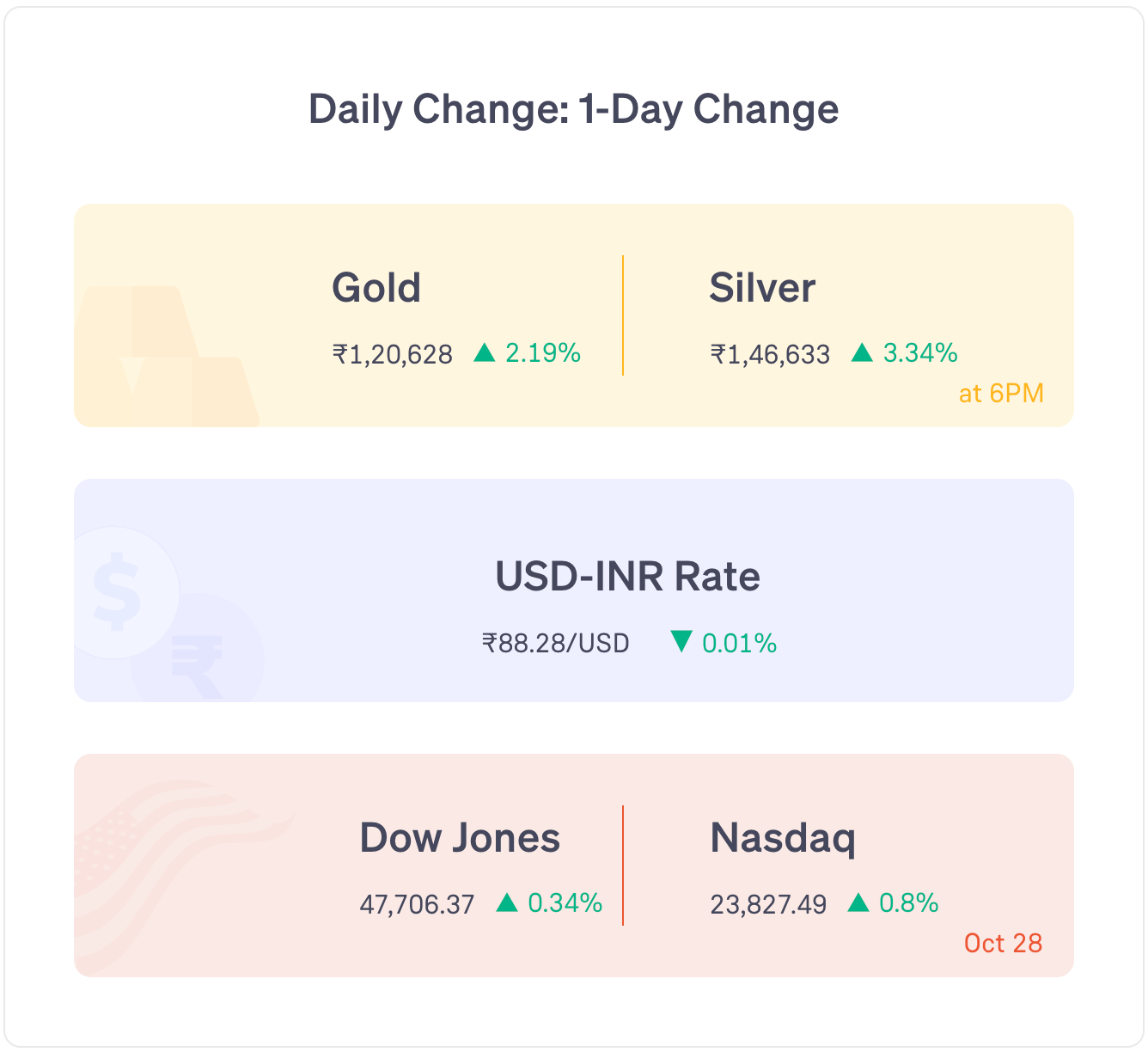SEBI's proposal for MF fees, BHEL net profit up 253%, & more — Groww Digest
Wednesday, 28 October 2025
Markets opened above yesterday’s closing point.
Nifty 50 rose throughout the day. The rise may have been driven by optimism over renewed hopes of a India-US trade deal after Trump made positive remarks about India. The positive sentiment was further supported by expectations of a US Fed rate cut, which is due later today.
All sectors’ stocks rose today except for auto stocks. Oil and gas stocks and metal stocks rose the most.
Global markets: US markets and Asian markets rose. Most European markets rose (as of 6 pm IST).
News
SEBI proposed changes to the mutual fund fee rules. It includes simpler fees, excluding taxes from costs, and lowering brokerage and transaction fees. SEBI has invited feedback from stakeholders till 17 Nov.
boAt filed an updated Draft Red Herring Prospectus (uDRHP) with SEBI for a Rs 1,500 crore IPO.
Orkla IPO has been subscribed 0.79 times. Retail subscription: 0.90 times. IPO closes on 31 Oct.
Stocks Updates
L&T: net profit rose 16% year-on-year to Rs 3,926 crore in the July-Sept quarter. It also received large orders ranging from Rs 2,500 crore to Rs 5,000 crore in Saudi Arabia to build a 380 kV substation and 420 km transmission lines.
BHEL: net profit rose 253% year-on-year to Rs 375 crore in the July-Sept quarter.
Varun Beverages: net profit rose 20% year-on-year to Rs 7,412 crore in the July-Sept quarter. The company will also incorporate a wholly owned subsidiary in Kenya for beverage manufacturing.
JSW Steel: increased its economic interest in Illawarra Metallurgical Coal to 30% (from 20%) through a $60 million investment via its subsidiary JSW Steel Netherlands.
Mazagon Dock: signed an agreement with Swan Defence to jointly build Landing Platform Docks (LPDs) for the Indian Navy under a public-private partnership.
Titan: company’s subsidiary, Titan Holdings International FZCO, acquired Signature Jewellery Holding in the UAE, making it a step-down subsidiary to manage Damas Jewellery business in the Gulf Cooperation Council (GCC) region.
Coal India: net profits rose 30% year-on-year to Rs 4,354 crore in the July-Sept quarter. Dividend declared: Rs 10.25 per share; record date: 4 Nov.
CG Power: net profits rose 30% year-on-year to Rs 287 crore in the July-Sept quarter.
Avenue Supermarts (DMart): received a Rs 20.87 lakh penalty notice from Haryana authorities for delay in executing a conveyance deed.
Word of the Day
Sovereign Wealth Fund (SWF)
It is an investment fund created and managed by a country’s government
It is a fund built with surplus money in the country — such as earnings from oil, natural resources, or forex reserves.
They invest in assets like stocks, bonds, real estate, infrastructure or other global assets to diversify and have stability in times of uncertain economic conditions.
They generate long term returns for the country.
Example: Norway’s Government Pension Fund Global, is one of the largest SWFs globally. Its funds mainly come from surplus from the country’s oil sector.
The National Investment and Infrastructure Fund (NIIF) is an SWF in India. Its funds come from various sources.
6 Day Course
Theme: red flags while choosing stocks
Day 3: Wednesday
Anything to do with lack of transparency can be a red flag.
As a shareholder you are entitled to the most necessary and basic information about a company.
Practices like accounting that hides real numbers, high ‘other expenses’ that are not explained, large changes/edits of records without justification, etc are classic examples of this.
Confusing or vague explanations, using complicated language that is difficult to understand by a large number of investors are also clear signs of lack of transparency.
A solid reason must exist if the management does not provide good guidance for future revenue and direction.
If no clear reason is mentioned, it is a red flag.
Sudden and unexpected resignation of senior executives without proper explanation or reason is also seen as lacking transparency.
Features Question
Q. “Many companies have announced their Q2 results. However, why are the dates different? Why don’t they release the results on the same date?”Quarterly results have to be announced within 45 days of the quarter ending. In case of the Jan-March quarter this is 60 days.
Different companies release their quarterly reports differently based on individual factors.
In the case of some companies, the auditing and accounting takes less time.
They tend to announce their reports sooner.
Others might take more time based on the complexity of internal procedures.
Many times, they plan their quarterly reports to avoid conflict with certain events (like a product launch they might be planning), other companies’ quarterly report announcements, etc.
This is why most companies’ reports come out at different times — but mostly within 45 days of the quarter ending.
Did you like this edition?
Leave a feedback here!





